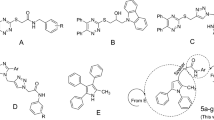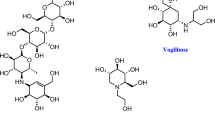Abstract
Fifteen carbohydrates (d-mannose, d-glucose, d-galactose, methyl-α-d-glucose, l-rhamnose, d-xylose, d-fructose, d-arabinose, dulcitol, mannitol, β-maltose, α-lactose, melibiose, sucrose, and raffinose) and four cyclitols [l-(+)-bornesitol, myo-inositol, per-O-acetyl-1-l-(+)-bornesitol, and quinic acid] were assayed for in vitro ACE inhibition. Of these molecules, per-O-Acetyl-1-l-(+)-bornesitol, quinic acid, methyl-α-d-glucose, d-rhamnose, raffinose, and the disaccharides were determined to be either inactive or weak ACE inhibitors, whereas l-(+)-bornesitol, d-galactose, d-glucose, and myo-inositol exhibited significant ACE inhibition. Molecular docking studies were performed to investigate interactions between active compounds and human ACE (Protein Data Bank, PDB 1O83). The results of various calculations showed that all active sugars bind to the same enzyme region, which is a tunnel directed towards the active site. With the exception of myo-inositol (K i = 13.95 μM, IC50 = 449.2 μM), the active compounds presented similar K i and IC50 values. d-Galactose (K i = 19.6 μM, IC50 = 35.7 μM) and l-(+)-bornesitol (K i = 25.3 μM, IC50 = 41.4 μM) were the most active compounds, followed by d-glucose (K i = 32.9 μM, IC50 = 85.7 μM). Our docking calculations are in agreement with the experimental data and show a new binding region for sugar-like molecules, which may be explored for the development of new ACE inhibitors.
Similar content being viewed by others
References
Akif, M., Georgiadis, D., Mahajan, A., Dive, V., Sturrock, E. D., Isaac, R. E., & Acharya, K. R. (2010). High-resolution crystal structures of Drosophila melanogaster angiotensinconverting enzyme in complex with novel inhibitors and antihypertensive drugs. Journal of Molecular Biology, 400, 502–517. DOI: 10.1016/j.jmb.2010.05.024.
Akif, M., Masuyer, G., Schwager, S. L. U., Bhuyan, B. J., Mugesh, G., Isaac, R. E., Sturrock, E. D., & Acharya, K. R. (2011). Structural characterization of angiotensin Iconverting enzyme in complex with a selenium analogue of captopril. The FEBS Journal, 278, 3644–3650. DOI: 10.1111/j.1742-4658.2011.08276.x.
Alderman, C. P. (1996). Adverse effects of the angiotensinconverting enzyme inhibitors. The Annals of Pharmacotherapy, 30, 55–61.
Bakris, G., Sowers, J., Epstein, M., & Williams, M. (2000). Hypertension in patients with diabetes. Why is aggressive treatment essential? Postgraduate Medicine, 107(2), 53–64. DOI: 10.3810/pgm.2000.02.884.
Bautista-Ibáñez, L., Ramírez-Gualito, K., Quiroz-García, B., Rojas-Aguilar, A., & Cuevas, G. (2008). Calorimetric measurement of the CH/π interaction involved in the molecular recognition of saccharides by aromatic compounds. The Journal of Organic Chemistry, 73, 849–857. DOI: 10.1021/jo701926r.
Brown, B., & Hall, A. S. (2005). Renin-angiotensin system modulation: The weight of evidence. American Journal of Hypertension, 18(Supplement), 127–133. DOI: 10.1016/j.amjhyper.2005.06.002.
Chen, S. J., Chang, C. T., Chung, Y. C., & Chou, S. T. (2007). Studies on the inhibitory effect of Graptopetalum paraguayense E. Walther extracts on the angiotensin converting enzyme. Food Chemistry, 100, 1032–1036. DOI: 10.1016/j.foodchem.2005.10.053.
Cornell, W. D., Cieplak, P., Bayly, C. I., Gould, I. R., Merz, K. M., Jr., Ferguson, D. M., Spellmeyer, D. C., Fox, T., Caldwell, J. W., & Kollman, P. A. (1995). A second generation force field for the simulation of proteins, nucleic acids, and organic molecules. Journal of the American Chemical Society, 117, 5179–5197. DOI: 10.1021/ja00124a002.
Cushman, D. W., Cheung, H. S., Sabo, E. F., & Ondetti, M. A. (1977). Design of potent competitive inhibitors of angiotensin-converting enzyme. Carboxyalkanoyl and mercaptoalkanoyl amino acids. Biochemistry, 16, 5484–5491. DOI: 10.1021/bi00644a014.
Endringer, D. C., Pezzuto, J. M., Soares, C. M., & Braga, F. C. (2007). l-(+)-Bornesitol. Acta Crystallographica Section E, E63, o1067–o1068. DOI: 10.1107/s1600536806037019.
Endringer, D. C., Pezzuto, J. M., & Braga, F. C. (2009). NF-κB inhibitory activity of cyclitols isolated from Hancornia speciosa. Phytomedicine, 16, 1064–1069. DOI: 10.1016/j.phymed.2009.03.022.
Ferreira, S. H., & Rocha e Silva, M. (1965). Potentiation of bradykinin and eledoisin by BPF (bradykinin potentiating factor) from Bothrops jararaca venom. Experientia, 21, 347–349. DOI: 10.1007/bf02144709.
Ferreres, F., Sousa, C., Valentão, P., Seabra, R. M., Pereira, J. A., & Andrade, P. B. (2007). Tronchuda cabbage (Brassica oleracea L. var. costata DC) seeds: Phytochemical characterization and antioxidant potential. Food Chemistry, 101, 549–558. DOI: 10.1016/j.foodchem.2006.02.013.
Fleming, I. (2006). Signaling by the angiotensin-converting enzyme. Circulation Research, 98, 887–896. DOI: 10.1161/01.res.0000217340.40936.53.
Hagiwara, S. Y., Takahashi, M., Shen, Y., Kaihou, S., Tomiyama, T., Yazawa, M., Tamai, Y., Sin, Y., Kazusaka, A., & Terazawa, M. (2005). A phytochemical in the edible Tamogitake mushroom (Pleuroutus cornucopie), d-manitol, inhibits ACE activity and lowers the blood pressure of spontaneously hypertensive rats. Bioscience, Biotechnology, and Biochemistry, 69, 1603–1605. DOI: 10.1271/bbb.69.1603.
Hooper, N. M., & Turner, A. J. (2003). An ACE structure. Nature Structural & Molecular Biology, 10, 155–157. DOI: 10.1038/nsb0303-155.
Hou, W. C., Chen, H. J., & Lin, Y. H. (2003). Antioxidant peptides with angiotensin converting enzyme inhibitory activities and applications for angiotensin converting enzyme purification. Journal of Agricultural and Food Chemistry, 51, 1706–1709. DOI: 10.1021/jf0260242.
Je, J. Y., Park, P. J., Kwon, J. Y., & Kim, S. K. (2004). A novel angiotensin I converting enzyme inhibitory peptide from Alaska pollack (Theragra chalcogramma) frame protein hydrolysate. Journal of Agricultural and Food Chemistry, 52, 7842–7845. DOI: 10.1021/jf0494027.
Koike, H., Ito, K., Miyamoto, M., & Nishino, H. (1980). Effects of long-term blockade of angiotensin converting enzyme with captopril (SQ14,225) on hemodynamics and circulating blood volume in SHR. Hypertension, 2, 299–303. DOI: 10.1161/01.hyp.2.3.299.
Li, G. H., Liu, H., Shi, Y. H., & Le, G. W. (2005). Direct spectrophotometric measurement of angiotensin I-converting enzyme inhibitory activity for screening bioactive peptides. Journal of Pharmaceutical and Biomedical Analysis, 37, 219–224. DOI: 10.1016/j.jpba.2004.11.004.
Lohith, K., Vijayakumar, G. R., Somashekar, B. R., Sivakumar, R., & Divakar, S. (2006). Glycosides and amino acyl esters of carbohydrates as potent inhibitors of angiotensin converting enzyme. European Journal of Medicinal Chemistry, 41, 1059–1072. DOI: 10.1016/j.ejmech.2006.04.005.
Ma, M. S., Bae, I. Y., Lee, H. G., & Yang, C. B. (2006). Purification and identification of angiotensin I-converting enzyme inhibitory peptide from buckwheat (Fagopyrum esculentum Moench). Food Chemistry, 96, 36–42. DOI: 10.1016/j.foodchem.2005.01.052.
Miodragović, D. U., Bogdanović, G. A., Miodragović, Z. M., Radulović, M. Đ., Novaković, S. B., Kaluđerović, G. N., & Kozłowski, H. (2006). Interesting coordination abilities of antiulcer drug famotidine and antimicrobial activity of drug and its cobalt(III) complex. Journal of Inorganic Biochemistry, 100, 1568–1574. DOI: 10.1016/j.jinorgbio.2006.05.009.
Morris, G. M., Goodesell, D. S., Halliday, R. S., Huey, R., Hart, W. E., Belew, R. K., & Olson, A. J. (1998). Automated docking using a Lamarckian genetic algorithm and an empirical binding free energy function. Journal of Computational Chemistry, 19, 1639–1662. DOI: 10.1002/(SICI)1096-987X(19981115)19:14〈1639::AID-JCC10〉3.0.CO;2-B.
Rapaport, D. C. (1996). The art of molecular dynamics simulation. New York, NY, USA: Cambridge University Press.
Sardinha, J., Guieu, S., Deleuze, A., Fernández-Alonso, M. C., Rauter, A. P., Sinaÿ, P., Marrot, J., Jiménez-Barbero, J., & Sollogoub, M. (2007). gem-Difluoro-carbasugars, the cases of mannopyranose and galactopyranose. Carbohydrate Research, 342, 1689–1703. DOI: 10.1016/j.carres.2007.05.021.
Schames, J. R., Henchman, R. H., Siegel, J. S., Sotriffer, C. A., Ni, H. H., & McCammon, J. A. (2004). Discovery of a novel binding trench in HIV integrase. Journal of Medicinal Chemistry, 47, 1879–1881. DOI: 10.1021/jm0341913.
Serra, C. P., Cortes, S. F., Lombardi, J. A., Braga de Oliveira, A., & Braga, F. C. (2005). Validation of a colorimetric assay for the in vitro screening of inhibitors of angiotensin-converting enzyme (ACE) from plant extracts. Phytomedicine, 12, 424–432. DOI: 10.1016/j.phymed.2004. 07.002.
Silva, G. C., Braga, F. C., Lima, M. P., Pesquero, J. L., Lemos, V. S., & Cortes, S. F. (2011). Hancornia speciosa Gomes induces hypotensive effect through inhibition of ACE and increase on NO. Journal of Ethnopharmacology, 137, 709–713. DOI: 10.1016/j.jep.2011.06.031.
Sowers, J. R., & Epstein, M. (1995). Diabetes mellitus and associated hypertension, vascular disease, and nephropathy. An update. Hypertension, 26, 869–879. DOI: 10.1161/01.hyp.26.6.869.
Sturrock, E. D., Natesh, R., van Rooyen, J. M., & Acharya, K. R. (2004). What’s new in the renin-angiotensin system? Cellular and Molecular Life Sciences, 61, 2677–2686. DOI: 10.1007/s00018-004-4239-0.
Vermeirssen, V., Van Camp, J., & Verstraete, W. (2002). Optimisation and validation of an angiotensin-converting enzyme inhibition assay for the screening of bioactive peptides. Journal of Biochemical and Biophysical Methods, 51, 75–87. DOI: 10.1016/s0165-022x(02)00006-4.
Watermeyer, J. M., Sewell, B. T., Schwager, S. L., Natesh, R., Corradi, H. R., Acharya, K. R., & Sturrock, E. D. (2006). Structure of testis ACE glycosylation mutants and evidence for conserved domain movement. Biochemistry, 45, 12654–12663. DOI: 10.1021/bi061146z.
Author information
Authors and Affiliations
Corresponding author
Rights and permissions
About this article
Cite this article
Endringer, D.C., Oliveira, O.V. & Braga, F.C. In vitro and in silico inhibition of angiotensin-converting enzyme by carbohydrates and cyclitols. Chem. Pap. 68, 37–45 (2014). https://doi.org/10.2478/s11696-013-0407-8
Received:
Revised:
Accepted:
Published:
Issue Date:
DOI: https://doi.org/10.2478/s11696-013-0407-8




